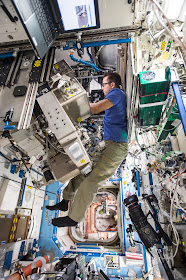ISS - Expedition 53 Mission patch.
Oct. 18, 2017
International Space Station (ISS). Animation Credit: NASA
(Highlights: Week of October 9, 2017) - Preparation for combustion experiments, samples for immune function studies, and tests of movement control and cognition were part of the science conducted aboard the International Space Station during another week that included a spacewalk.
European Space Agency astronaut Paolo Nespoli worked on reconfiguring the Combustion Integrated Rack (CIR) ahead of the upcoming Advanced Combustion via Microgravity Experiments (ACME) investigation. The CIR is used to perform combustion experiments in microgravity. The Multi-user Droplet Combustion Apparatus (MDCA) Chamber Insert Assembly (CIA) from the CIR combustion chamber was removed for the final time, and was replaced by the ACME chamber insert. The ACME investigation is a set of five independent studies of gaseous flames to be conducted in the CIR. ACME’s primary goal is to improve fuel efficiency and reduce pollutant production in practical combustion on Earth. Its secondary goal is to improve spacecraft fire prevention through innovative research focused on materials flammability.
Image above: European Space Agency (ESA) astronaut Paolo Nespoli works on reconfiguring the Combustion Integrated Rack (CIR) ahead of the upcoming Advanced Combustion via Microgravity Experiments (ACME) investigation. Image Credit: NASA.
Astronauts also collected samples for the Multi-omics analysis of human microbial-metabolic cross-talk in the space ecosystem (Multi-Omics) investigation this week. It has been suggested that living aboard the orbiting laboratory likely causes immune dysfunction in astronauts, but the precise underlying mechanisms for this dysfunction is not well understood. Recent studies have indicated that an imbalance in gut microbiota composition, or dysbiosis, resulting from a variety of environmental stresses, could lead to immune dysfunction. Therefore, metagenomic analysis of the gut microbiota from astronauts should result in better understanding of the immune dysfunction of crew members on the space station. Multi-Omics could identify candidates of bacterial and/or metabolic biomarkers for immune dysfunction which could be useful for the health management of astronauts.
Crew members set up the Spaceflight Effects on Neurocognitive Performance: Extent, Longevity, and Neural Bases (NeuroMapping) hardware, and performed their Flight Day 30 tests in “strapped in” and “free floating” body configurations. During the test, the astronauts executed three behavioral assessments: mental rotation, sensorimotor adaptation and motor-cognitive dual tasking. The NeuroMapping investigation studies whether long-duration spaceflight causes changes to brain structure and function, motor control or multi-tasking abilities. It also measures how long it takes for the brain and body to recover from possible changes. Previous research and anecdotal evidence from astronauts suggests movement control and cognition can be affected in microgravity. The NeuroMapping investigation performs structural and functional magnetic resonance brain imaging (MRI and fMRI) to assess any changes that occur after spending months on the space station.
Image above: NASA astronaut Joe Acaba configured the back of the Optics Bench for the Light Microscopy Module (LMM) upgrades, in preparation for the ACE-T-6 investigation. Image Credit: NASA.
While physical changes in astronauts’ bodies were studied, so too were changes in the crew’s culture. The Canadian Space Agency investigation, Culture, Values, and Environmental Adaptation in Space (At Home in Space), assesses culture, values, and psychosocial adaptation of astronauts to a space environment shared by multinational crews on long-duration missions. It is hypothesized that astronauts develop a shared space culture that is an adaptive strategy for handling cultural differences, and that they deal with the isolated confined environment of the spacecraft by creating a home in space. At Home In Space uses a questionnaire battery to investigate individual and culturally-related differences, family functioning, values, coping with stress and post-experience growth.
Potential benefits of this work include a better understanding of the inter- and intrapersonal factors that may affect long space missions, which may ultimately facilitate the development of more effective countermeasures and empowerment strategies for long-duration missions. Other benefits would be the design of effective procedures to enhance crew feeling at home in space. Findings could also have applications to people living in remote, confined, and isolated environments (e.g., oil rigs, long-voyage tankers, and the Arctic and Antarctic), and to those whose employment requires periodic absences from family (e.g., military deployments).
Space to Ground: Quick Work: 10/13/2017
Video above: NASA's Space to Ground is your weekly update on what's happening aboard the International Space Station. Video Credit: NASA.
Progress was also made on the following investigations last week: Fine Motor Skills, Veg-03, Lighting Effects, Space Headaches, ISS Ham Radio, Advanced Nano Step, Plasma Kristall-4, Biochemical Profile and ACE-T-6.
Related links:
Expedition 53: https://www.nasa.gov/mission_pages/station/expeditions/expedition53/index.html
Combustion Integrated Rack (CIR): https://www.nasa.gov/mission_pages/station/research/experiments/326.html
Advanced Combustion via Microgravity Experiments (ACME): https://www.nasa.gov/mission_pages/station/research/experiments/1908.html
Multi-Omics: https://www.nasa.gov/mission_pages/station/research/experiments/1949.html#top
NeuroMapping: https://www.nasa.gov/mission_pages/station/research/experiments/1007.html
At Home in Space: https://www.nasa.gov/mission_pages/station/research/experiments/1988.html
Fine Motor Skills: https://www.nasa.gov/mission_pages/station/research/experiments/1767.html
Veg-03: https://www.nasa.gov/mission_pages/station/research/experiments/1294.html
Lighting Effects: https://www.nasa.gov/mission_pages/station/research/experiments/2279.html
Space Headaches: https://www.nasa.gov/mission_pages/station/research/experiments/181.html
ISS Ham Radio: https://www.nasa.gov/mission_pages/station/research/experiments/346.html
Advanced Nano Step: https://www.nasa.gov/mission_pages/station/research/experiments/783.html
Plasma Kristall-4: https://www.nasa.gov/mission_pages/station/research/experiments/1343.html
Biochemical Profile: https://www.nasa.gov/mission_pages/station/research/experiments/1008.html
ACE-T-6: https://www.nasa.gov/mission_pages/station/research/experiments/1968.html
Space Station Research and Technology: https://www.nasa.gov/mission_pages/station/research/index.html
International Space Station (ISS): https://www.nasa.gov/mission_pages/station/main/index.html
Animation (mentioned), Images (mentioned), Video (mentioned), Text, Credits: NASA/Erling. G. Holm/John Love, Lead Increment Scientist Expeditions 53 & 54.
Best regards, Orbiter.ch




